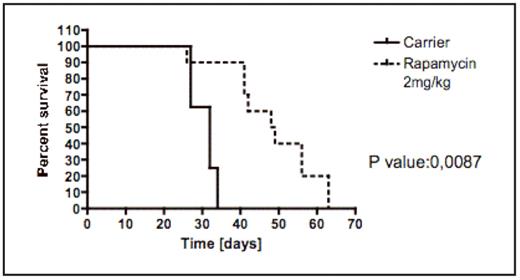Abstract
Neurotrophins (NTs) and their receptors play a key role in neurogenesis and survival. The TRK (tropomyosin-related kinase) receptor protein tyrosine kinases (TRKA, TRKB, TRKC) are high affinity NT-receptors that are expressed in a variety of human tissues. Their role in normal and malignant hematopoiesis is poorly understood. Recently, we and others have obtained evidence for potential involvement of this receptor system in leukemia. In a prospective study involving 94 adult patients, we demonstrated for the first time cell surface expression of the three TRKs and constitutive activation in blasts from patients with de novo or secondary acute leukemia. At least one TRK receptor was expressed in 55% of the analyzed cases (Li Z et al., ASH 2007). Altered TRK signaling efficiently transformed murine hematopoietic stem/progenitor cells (Meyer J et al., Leukemia 2007; Li Z et al., ASH 2007). We observed constitutive activation of mammalian target of rapamycin (mTOR) both in murine and human leukemic cells. Murine leukemic cells induced by altered TRK signaling were very sensitive to rapamycin treatment in vitro. We next tested the therapeutic effect of rapamycin on altered TRK-induced leukemia in a mouse model (C57Bl/6J). Leukemic cells isolated from #483 mouse transplanted with primary hematopoietic stem/progenitor cells modified with deltaTrkA, an active mutant of TRKA isolated from a patient with acute myeloid leukemia, grew factor-independently. Treatment of #483 cells with rapamycin (10–50nM) induced apoptosis and showed a dose-dependent growth inhibition (up to 100%) in colony forming assay. Consistently, mTOR was strongly dephosphorylated. In pilot studies, we found that
transplantation of 106 #483 cells into recipients constituted with sublethal irradiation (7.5Gy) gave rise to leukemia development in all animals after a latency of 8 weeks;
Daily i.p. injection of 2mg/kg rapamycin in healthy animals mediated a high level of rapamycin in whole blood (around 50ng/ml).
Thus, after irradiation, 20 animals were transplanted with 106 #483 cells and randomized in two groups. One group was treated daily with rapamycin 2mg/kg i.p., the other group received only carrier (placebo). The treatment begun 3 weeks after transplantation and continued until the last animal succumbed to leukemia. Rapamycin treatment significantly prolonged the survival of animals compared with control group (mean survival 48.5 and 32 days, respectively, P=0.0087) (Figure 1). Concentration of rapamycin in whole blood at the time of end point analysis ranged 26–151ng/ml. Our findings suggest that mTOR plays an important role in leukemogenesis induced by altered TRK signaling. TRKs and mTOR might serve as therapeutic targets in acute leukemia.
Kaplan-Meier estimate of survival of animals after treatment.
Kaplan-Meier estimate of survival of animals after treatment.
Disclosures: No relevant conflicts of interest to declare.
This study was supported by the Deutsche Krebshilfe (grant: 10-2090-Li I). MR receives a stipend of the Deutsche Jose Carreras Gesellschaft (DJCLS). We thank Martijn Brugman for helping with statistical analysis, Thomas Neumann and Cindy Elfers for mouse visit and analysis.
Author notes
Corresponding author


This feature is available to Subscribers Only
Sign In or Create an Account Close Modal